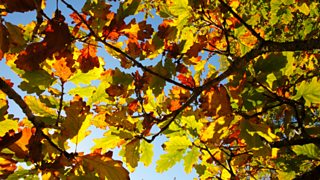The Woodland Trust鈥檚 Nature鈥檚 Calendar project encourages members of the public to get out and about in their gardens and local areas and to record common signs of autumn.

Sessile oak in autumn colour
This year our recorder鈥檚 data already shows autumn is late. Across the country, first sightings of leaves changing colour are around 14 days later than average for some of our best-loved tree species such as elder, and .听听
Weather conditions affect the development of the stunning autumn colour we are so used to and, while later than usual, this year鈥檚 weather has provided the ideal conditions for vibrant leaf tinting.
In autumn the colder nights and lowering temperatures destroy chlorophyll inside leaf structures, meaning vibrant green shades fade to yellow. If temperatures stay above freezing and there are dry, sunny days, then we can expect more red hues, leading to a fiery and truly spectacular autumn display.听
The Woodland Trust needs more members of the public to help us record autumn sightings on听the .
Every single sighting counts, and this kind of citizen science information helps the Woodland Trust, government and research scientists to understand the impacts of weather and climate on our native species.
Anyone can become a Nature鈥檚 Calendar recorder - make your love of nature count.
听
